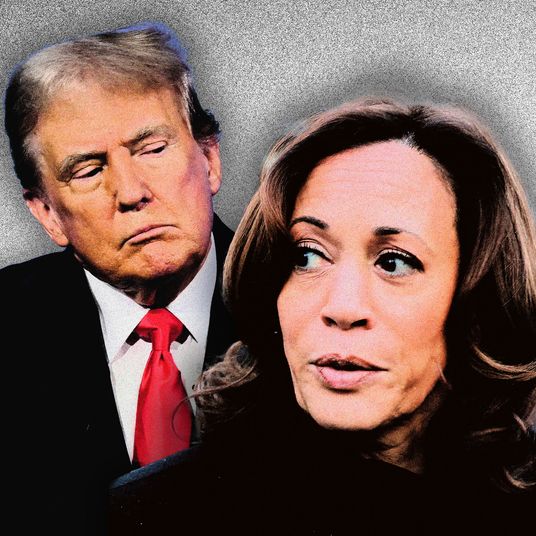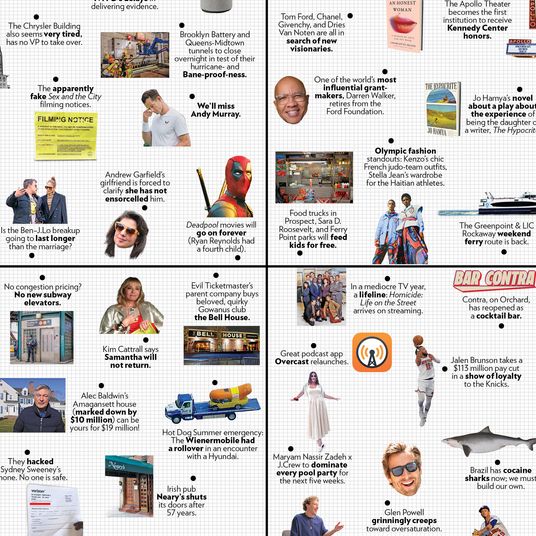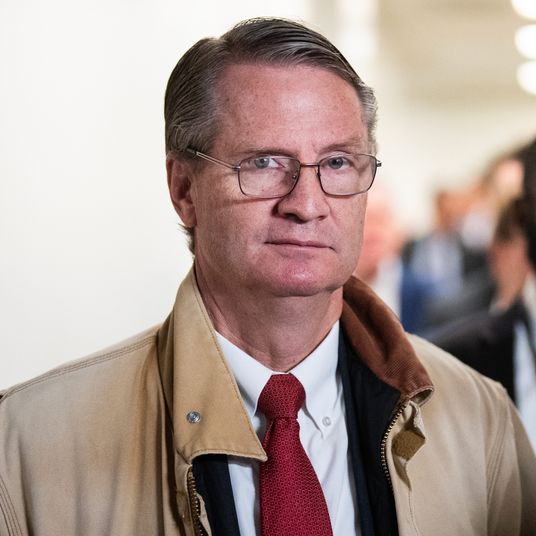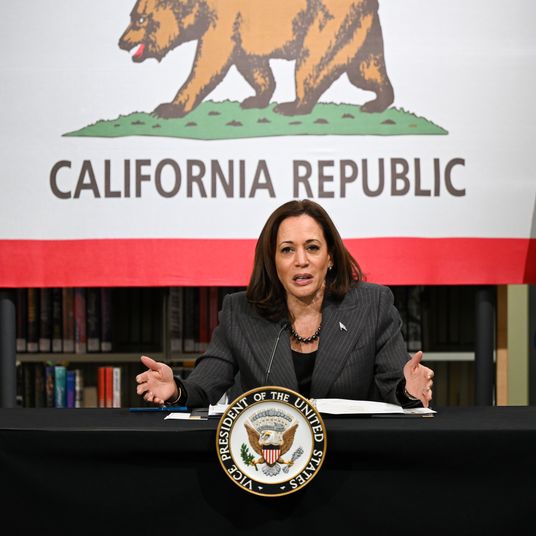
The Trump campaign’s press secretary, Karoline Leavitt, is in a tough spot. Like many who have worked for Trump, she contributed to Project 2025, and she is being forced to attack the project she helped create. “Project 2025 is not related to our campaign and does not reflect official campaign policy,” she told me the same week Trump himself denounced the project as “ridiculous and abysmal.” She isn’t the only one. Stephen Miller, for example, is performing rhetorical gymnastics while attempting to claim he has “never been involved with Project 2025” despite his having worked on a training-program video and the legal group he runs serving as a partner for the project. (By mid-July, his group and two more quit.)
The attacks are unexpected and deeply ironic: Project 2025 is a proposed road map for a second Trump term produced by the conservative think tank the Heritage Foundation and designed by former, and potentially future, members of his administration. Of the 37 authors of the project’s core agenda, 27 came from Trump’s orbit, including prominent figures such as former Housing and Urban Development Secretary Ben Carson, former acting Secretary of Defense Christopher Miller, and economic adviser Peter Navarro. Even more former administration and current campaign members helped craft other portions, like John McEntee, the former director of the White House Presidential Personnel Office, who served as a senior Heritage adviser working on personnel for a second term. McEntee said in an interview this year that while he had not coordinated directly with the campaign, Project 2025 will “integrate a lot of our work with them” once Trump assembles an official transition team.
“It’s totally false he doesn’t know what P25 is,” one former senior adviser said of Trump’s remarks. “Privately, he is of course talking to Heritage, and [Heritage president] Kevin Roberts has reportedly even met with Trump on P25.”
Conversations with current and former Trump staffers suggest that the policies of Project 2025 aren’t what have earned Trump’s ire — such as eliminating the Education Department and putting the president directly in charge of the FBI and the Justice Department — but rather how it has created the perception that someone else is in charge. Indeed, Project 2025 is a set of ideas that represents an attempt by the conservative movement to codify what “Trumpism” is so that it can survive after Trump. And as Trump and his campaign have made clear, in his eyes he is the movement.
Two former administration officials pointed to the Biden campaign’s success at tying Project 2025’s most controversial elements to Trump as a probable point of annoyance for the former president. One former senior adviser to Trump puts it bluntly: “My guess is he doesn’t like getting attacked for something he didn’t personally okay.” There is a good chance, though, that he will use at least the project’s list of loyalists to staff a second administration.
The tension goes back to last April when Heritage published part of the project before the Republican primary had even taken place. In December, Trump campaign advisers Chris LaCivita and Susie Wiles sent out a memo criticizing Project 2025 and other plans from external groups. “Some ‘allies’ haven’t gotten the hint,” the two wrote. “Let us be very specific here: unless a message is coming directly from President Trump or an authorized member of his campaign team, no aspect of future presidential staffing or policy announcements should be deemed official.” LaCivita and Wiles forcefully pushed back against the perception that Trump would not be the driving force behind his own presidency, emphasizing in their memo that policy and personnel decisions “will follow President Trump’s lead,” not that of Heritage or others.
While Heritage had been famous as a pro-business, socially conservative think tank that supported a hawkish approach to foreign affairs, it has steadily embraced Trump under the tenure of Roberts, who took over as Heritage president in 2021 and established himself as such a staunch Trump ally that Steve Bannon suggested he could be a potential Trump White House chief of staff. “The conservative promise must be more than simply free markets and free trade, cheap credit, cheap imports, or cheap foreign labor. We’ve been there, and it didn’t work,” Roberts said at Heritage’s 50th-anniversary celebration. What does work, in Roberts’s mind, is Trump, whom he has praised for showing “that a burgeoning, working-class, pan-ethnic conservative majority exists in this country.” Roberts is open about his vision of Project 2025 as “institutionalizing Trumpism.” He takes an extreme view of the political struggle between Trump and his opponents, telling a guest host on Bannon’s podcast on a July 2 podcast that he believed America to be “in the process of the second American Revolution, which will remain bloodless if the left allows it to be.”
The MAGA turn has alienated some former employees, however, who The Dispatch reported have accused Heritage leadership of putting Trump’s political views ahead of its mission. Luke Coffey, Heritage’s former director of foreign policy, quit after the think tank’s leaders opposed sending support to Ukraine following Russia’s invasion. Other former employees say the high staff turnover at Heritage in recent years is due to leadership ignoring the scholarship and restricting criticism of Trump under Roberts.
What Heritage is trying to do for Trump isn’t exactly new, but Roberts put the whole thing on steroids for the 2024 election. Broadly speaking, the project can be split into two parts: a personnel database and a series of policy proposals titled “Mandate for Leadership.” Heritage has put together personnel lists for potential administrations in the past, but this time it has a goal of identifying 20,000 potentially loyal officials by the end of this year. Heritage has produced Mandates for Leadership for Republican presidential candidates going back to Ronald Reagan. These mandates can be quite influential — Donald Devine, director of the Office of Personnel Management during Reagan’s first term, says that “if it hadn’t been for their book, we would not have been able to do what we did.” And in 2018, Heritage bragged that Trump had adopted almost two-thirds of the policy recommendations from its 2016 mandate.
Roberts put the personnel and policy efforts under one umbrella, dubbing it Project 2025, a clever bit of marketing that garnered attention and personnel applications, and partnered with over 100 other conservative groups to increase the project’s stature. Those groups include prominent conservative organizations like the American Legislative Exchange Council, the NRA, and Liberty and Hillsdale universities. They also include seven organizations identified by the Southern Poverty Law Center as hate or extremist groups, including the Center for Immigration Studies, which was designated a hate group “for its decadeslong history of circulating racist writers, while also associating with white nationalists.” (CIS denies this.)
Trump has actually released an agenda for his second term, dubbed “Agenda 47” by his campaign, which Leavitt pointed to as “the only policy that should be written about in regard to our campaign.” It’s a series of videos characterized by Washington Post columnist Philip Bump as “a pastiche of promises and rhetoric that centers heavily on the things Republican primary voters wanted to hear in 2023.” Trump rarely brings up Agenda 47, and the campaign declined requests to discuss it in detail. The campaign’s vague handling and outlining of the policy ideas have led some Trump allies to focus on the RNC platform, over which Trump has exerted a great deal of influence this year in toning down. Roger Stone, a longtime Trump friend and former adviser, says the party’s platform “will be a more accurate reflection of Trump’s plans and philosophy” than Project 2025.
But it’s hard to deny that Trump’s plans and philosophy aren’t found in Project 2025 as well. His handpicked policy director for the Republican convention’s platform is one of the authors of Project 2025: Russ Vought served as director of the Office of Management and Budget under Trump and wrote Project 2025’s policy section on the executive office of the president.
Despite Trump’s annoyance with Project 2025, it seems probable that he will wind up being particularly enticed by its personnel database, overseen by McEntee. Heritage’s recruitment of future bureaucrats represents a potential massive change to the U.S. government that could last well beyond a second Trump term. Trump is said to be fond of McEntee, and Rolling Stone reports that people close to Trump say he will likely have a senior position in a second term if he wants it. During his time overseeing the White House Presidential Personnel Office in Trump’s administration, McEntee played a role in the creation of Schedule F, a classification that made thousands of civil-servant positions more easily filled by Trump loyalists.
McEntee’s thinking on the subject was influenced by Devine’s book Reagan’s Terrible Swift Sword: Reforming and Controlling the Federal Bureaucracy, which details how Devine shrank government under Reagan. McEntee “called me in and asked for my expertise,” says Devine, who co-authored Project 2025’s section on bureaucratic reform. “Later on, they asked me to go over to the Office of Personnel Management and kind of see what things were.”
In Project 2025, Devine argues that reclassifying certain civil-servant positions would allow administrations greater control over who is implementing and advocating for policy, rather than being forced to rely on career bureaucrats. Critics say this would strip many civil servants of job protections meant to ensure continuity from administration to administration, effectively allowing Trump, who has expressed his support for the Schedule F plan, to fire those who don’t go along with his plans and replace them with loyalists.
“It has nothing to do with being fired; it means you can move people around,” said Devine.
Both Trump and Project 2025 have expressed support for reintroducing Schedule F, and Project 2025 is actively compiling a database of interested individuals to fill such roles using a questionnaire meant to weed out those whose politics don’t align with the plan. There are questions about whether applicants agree with such statements as “The U.S. should increase legal immigration,” “The police in America are systemically racist,” or “The President should be able to advance his/her agenda through the bureaucracy without hinderance from unelected federal officials.” If Trump wins in November, McEntee and his database are a logical place for him to look for staff.
After Trump denounced Project 2025, Heritage sent out an email asking for help in combating a presidential candidate who had “declared an all-out war on the Heritage Foundation and our Project 2025 initiative,” accusing the candidate of “attacking The Heritage Foundation out of desperation.”
The subject of the email was Joe Biden. For Trump, who also insulted the project but whose approval Heritage desperately wants, a spokesperson for the group had a more moderated response: “It is ultimately up to that president, who we believe will be President Trump, to decide which recommendations to implement.”
Correction: A previous version of this story misstated who Roberts spoke to on Bannon’s podcast.





























